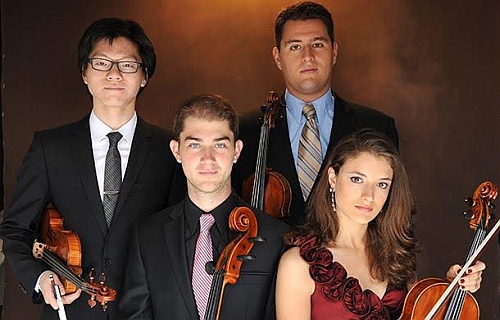 Canada Dvorak, Berg and Beethoven: Dover Quartet (Joel Link and Bryan Lee, violins, Milena Pajaro-van de Stadt, viola, Camden Shaw, cello), Vancouver Playhouse, 20.10.2015 (GN)
Canada Dvorak, Berg and Beethoven: Dover Quartet (Joel Link and Bryan Lee, violins, Milena Pajaro-van de Stadt, viola, Camden Shaw, cello), Vancouver Playhouse, 20.10.2015 (GN)
Dvorak: String Quartet in F major, Op. 96, ‘American’
Berg: String Quartet, Op. 3
Beethoven: String Quartet in F major, Op. 59, No. 1, ‘Razumovsky’
It is always exciting to track a young ensemble from its birth pangs, so to speak, and I have been able to follow this string quartet very closely since their stunning victory at the Banff International String Quartet Competition in 2013. The title above indicates my enthusiasm over the progress which they’ve made since I reviewed them with the title ‘The Dover Quartet Rides High’ a year ago. The ensemble served as the first-ever Quartet-in-Residence at the Curtis Institute in 2013-2014. They now hold the same title at Northwestern University and, just last month, received the 2016-2018 Cleveland Quartet Prize. The ensemble was mentored principally by the Guarneri and Vermeer Quartets.
One of the real treats this time was hearing their Dvorak ‘American’ Quartet, which revealed great strides in both refinement and balance, and their ability to convey an intimacy in their playing. It is easy to overpower this work and push it forward with a fulsome vigour that is simply not part of the Czech idiom. The first two movements were almost perfection in combining an inward beauty and restraint with a natural enthusiasm. The music was often quietly projected, yet had such a lovely tonal and rhythmic balance that that the work moved forward effortlessly, and with the right tinge of melancholy too. The timbres were lovely: Ms Pajaro-van de Stadt’s viola brought out telling rustic colour on many occasions, while Camden Shaw’s inward musings on the cello were exceptionally communicative, especially in the lovely slow movement. I thought that this was cello playing of a rare order.
The remaining two movements were attractive, if on a slightly less exalted plane. The Scherzo was perhaps a little cautious: it could have achieved a fuller and more natural rhythmic flow if it accented and pushed off the second note in the opening motive. The dancing rhythms of the Finale were beguilingly captured by Joel Link’s violin, and the energy at the end was spontaneous and convincing. Only at a few moments here and perhaps earlier – and I mean only a few – did they push too hard for thrusting, demonstrative statement. Other than participating in the joys of youthful exuberance, I can see no reason for it. The quartet is tonally strong enough as it stands: there is no extra additive needed to carry the force of the music. I also think their otherwise pristine balance suffers with this type of stress: Joel Link’s violin seems to separate from the texture to a slight degree.
Alban Berg’s Quartet, Op. 3 (1910) comes from a quite different tradition, but the Dover’s interpretation was equally accomplished. In fact, this was a remarkably mature and finished reading. The ensemble has a sentimental attachment to this piece since, as the violist recalled: ‘When we were in our studies, a call was put out for willing volunteers to actually try to play this piece. Somehow, the four of us showed up, and that’s how we met. It’s over seven years later, and we’re still together’. Textures were warmer and fuller here, as they should be for an early work that closely mimics the post-romantic emotionalism of Schoenberg’s Verklaerte Nacht. What especially impressed was the cohesion of the interpretation, full of structural awareness and judicious pacing to underpin the expressive fabric. Lines were always cleanly drawn, yet full of the right sort of angst and dramatic fervour when needed.
Beethoven’s first ‘Razumovsky’ is the composer’s greatest and longest work in this genre outside of the late quartets, and apparently the Dover Quartet had only performed it a few times before. One big plus is that the ensemble had no difficulty in seeing their way through the work, progressing intelligently to a closing Allegro of considerable fire and excitement. Yet there was also no doubt that it was a preliminary effort. It could have used more of the ‘fineness’ in articulation and quiet subtlety achieved in the earlier Dvorak, and I should be clear in stating that not all quartets are lucky enough to find this special quality. This was rather big-boned traditional playing, bold and full in texture, with dynamics only fitfully moving below mezzo-forte and climaxes of considerable thrust and power. Beethoven in this day and age needs to be less ‘padded’ and less imbued with fulsome romantic sentiment. This interpretation can stand to be leaner, with more soft, inward playing in the first and third movements, and perhaps a sharper question and answer between the voices in the second. The extensive vibrato and portamenti in the Adagio, in particular, created far too luxuriant textures. Again, I think it is unnecessary for the ensemble to attack climactic moments with as much zeal and force.
This programme offered a stunning array of ‘big’ works, and I would be hard pressed to find a more enjoyable combination. I was thrilled to see these young artists again and observe them as they move forward so convincingly day by day.
Geoffrey Newman
Previously published in a slightly different form on http://www.vanclassicalmusic.com